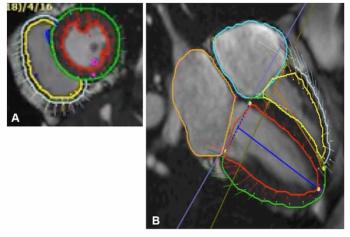
Technology, physiology streamline cardiac CTA contrast dose
Increasing CT scanning speeds and image resolution combined with automated injection and optimized protocols tailored to specific patient features could reduce iodinated contrast media needed for coronary CT angiography by at least half, according to several papers presented at the 2009 RSNA meeting.
Increasing CT scanning speeds and image resolution combined with automated injection and optimized protocols tailored to specific patient features could reduce iodinated contrast media needed for coronary CT angiography by at least half, according to several papers presented at the 2009 RSNA meeting.
“We have a great opportunity to improve the effectiveness with which we use iodine, focusing on patient-specific factors,” said Dr. Geoffrey D. Rubin, a professor of radiology at Stanford University, who moderated a cardiovascular session Tuesday.
German researchers released results of two studies that relied on the wide area detector capacity of the latest-generation 320-slice CT scanners for contrast media volume reduction in coronary CTA.
In the first study, Dr. Alexander Lembcke and colleagues at Charitè Medical University in Berlin compared a low- and a standard-dose contrast protocol in 60 consecutive patients with body weights ranging from 60 to 80 kg. Thirty of them received a 35-mL dose of contrast injected at 7.5 mL/sec (group A), while the remainder got a 70-mL dose injected at 5 mL/sec (group B). All patients underwent automated contrast injection and a prospective ECG-gated CTA protocol for evaluation of the main pulmonary artery, left atrium, left ventricle, ascending aorta, descending aorta, and left and right coronary arteries.
Although group A had lower atrial and ventricular enhancement compared with group B, neither group showed a statistically significant difference for enhancement of the pulmonary, aortic, or coronary branches.
The second study group, also from Charitè Medical University and led by Dr. Patrick Hein, assessed 40 consecutive male patients previously referred for coronary imaging. Patients were divided into four groups that respectively received 40-mL, 50-mL, 60-mL, and 70-mL doses of iodinated contrast. Although the 50-mL dose provided the best image quality with the lowest dose, the investigators found that even a dose as low as 40 mL could provide images of diagnostic quality.
In another study, investigators from China released results on an optimized contrast injection protocol adapted to patient body weight for use with a 64-slice CT scanner. The investigators enrolled 100 consecutive patients into two groups that respectively received a 65-mL dose at 5 mL/sec (group 1) and a 40-mL dose at 5 mL/sec (group 2). Each group was further divided depending on whether patients weighed more or less than 70 kg.
The researchers found the body weight-based contrast injection CTA protocol could save a significant amount of contrast particularly for average and smaller patients while improving aortic and coronary enhancement in larger patients.
Contrast injections customized to each patient using protocols based on fixed volumes and flow rates for optimal image enhancement are a nice start. But what is ultimately needed is an iodine dosing strategy that focuses comprehensively on patient physiology, Rubin told Diagnostic Imaging.
Newsletter
Stay at the forefront of radiology with the Diagnostic Imaging newsletter, delivering the latest news, clinical insights, and imaging advancements for today’s radiologists.


























